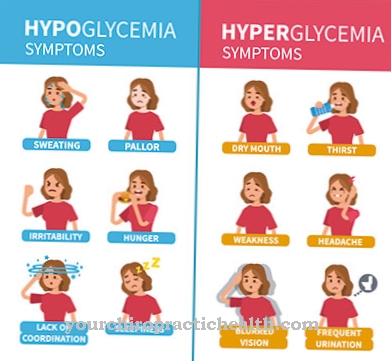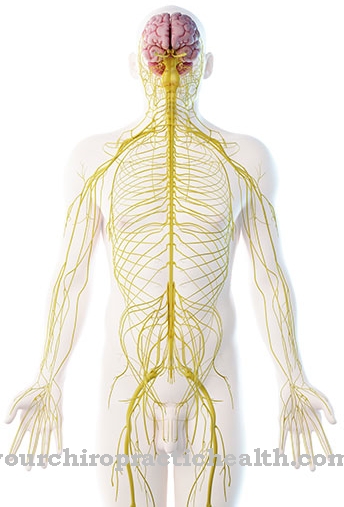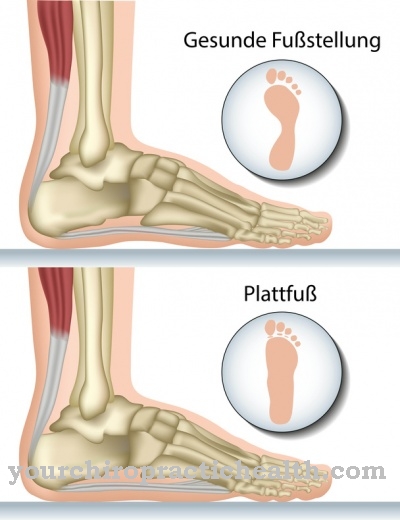The Kussmaul breathing describes a type of breathing that can indicate an illness. This disease is acidosis, the overacidification of the body due to a disruption of the acid-base balance.
What is Kussmaul breathing?

© Henrie - stock.adobe.com
The Kussmaul breathing was named after the biologist and physician Adolf Kussmaul. It is also called Acidosis breathing as well as Acidosis compensation breathing designated. It is a type of breathing called hyperventilation. There is very deep and rapid breathing to increase the uptake of oxygen.
This breathing is caused by metabolic acidosis. This leads to an acidification of the blood in the body of the person concerned. The pH of the blood drops below 7.35 due to an accumulation of protons. The pH value is a measured value for the acidity caused by acids and bases in the body. Acids have a pH value of less than 7 in aqueous solution and bases have a pH value of over 7. The physiological pH value of humans is between 7.35 and 7.45.
causes
The main cause of Kussmaul breathing is metabolic acidosis. The reasons for the occurrence of acidosis are varied. It can come from diabetes mellitus, which has not been properly controlled by medication, or from lactic acidosis, the accumulation of lactic acid in the body.
Other causes include alcoholic ketoacidosis or prolonged starvation. Other causes of acidosis are methanol or salicylic poisoning. Acidosis can also be caused by diarrhea, a condition that causes the bowel to empty noticeably.
In addition, renal insufficiency, the failure of the kidneys, which leads to an accumulation of so-called urinary substances in the blood, or Addison's disease are causes of acidosis. Addison's disease is a life-threatening condition that results in a loss of adrenal function.
Symptoms, ailments & signs
The symptoms of Kußmaul breathing are altered breathing similar to hyperventilation and metabolic acidosis. This acidosis can be identified by the characteristic smell of the person's breath. Through Kußmaul breathing, the body tries to remove carbon dioxide, which can be a source of acidosis, by exhaling strongly, to normalize the pH value in the blood and thus to reduce the acidosis.
In addition to breathing, an enlarged liver and high blood sugar, which can also be used as a sign of diabetes mellitus, are indicators of a congenital metabolic disorder. This is a congenital disease, which is divided into different categories, depending on the type of metabolism or metabolism that is impaired.
A distinction is made between the carbohydrate, amino acid, steroid metabolism and the metabolism of lysosomal storage. Lysosomes are small membrane formations that contain enzymes that are used to break down parts of the cell that are no longer needed or no longer functional, so that they can be reused.
Diagnosis & course of disease
Kußmaul breathing is based on metabolic acidosis. This is determined using a blood gas analysis. This analysis determines the pH value and the concentration of oxygen and carbon dioxide in the blood. The pH of an adult should be between 7.35 and 7.45. The carbon dioxide partial pressure is usually 35 to 45 mm. So-called compensated hyperacidity can also occur.
Then the pH value is in the normal range, but the other values of the analysis indicate a malfunction. In addition, the pH of the urine can also be determined in order to test the person concerned for possible acidosis. In the course of acidosis, there is a lack of oxygen. The organs are not supplied with enough oxygen. To compensate for the increased acidity, the body releases more water.
The increased acidification of the body can lead to tachycardia (rapid heartbeat). Other sequelae include impaired consciousness, decreased blood pressure, osteoporosis, rheumatoid arthritis, arteriosclerosis and diseases of the heart. Atherosclerosis is the hardening of the arteries, which can lead to a heart attack. Rheumatoid arthritis is a disease of the joints that often appears with increasing age.
Complications
With Kußmaul breathing, those affected in most cases suffer from severe hyperventilation. This leads to breathing difficulties and those affected sometimes suffer from severe tiredness and fatigue. It is also not uncommon for the patient to be less resilient. The liver is also not infrequently enlarged and causes pain.
Liver problems are generally dangerous and in the worst case scenario can lead to death. The patient's metabolism is also restricted by Kussmaul breathing, which leads to digestive disorders and other complaints. The patient's quality of life is significantly reduced by this disease. It is not uncommon for the symptoms to lead to mental illness or depression.
Furthermore, it is not uncommon for palpitations and disorders of consciousness. Patients may pass out or fall into a coma. The treatment of Kußmaul breathing is carried out with the help of medication. As a rule, complications do not arise. However, treatment of the underlying disease is also necessary to prevent further consequential damage.
When should you go to the doctor?
Anyone who notices a strong bad breath that cannot be remedied by strict oral hygiene should consult their family doctor or dentist. If accompanying signs of liver enlargement occur (such as liver pain or jaundice), a doctor must be consulted immediately. Severe fatigue, breathing difficulties and reduced resilience are further warning signs that require immediate clarification. In the event of cardiovascular complaints or hyperventilation, the emergency doctor must be called or the sick person must go to a clinic.
Patients suffering from diabetes, alcoholic ketoacidosis, chronic diarrhea or renal insufficiency are particularly prone to developing Kussmaul breathing. The symptoms also occur in the context of Addison's disease and lactic acidosis. People who are part of these risk groups should go straight to the doctor's office so that any complications can be clarified and treated comprehensively. During the treatment, the patient must see the doctor regularly. Since metabolic acidosis can recur, further examinations are required after treatment.
Treatment & Therapy
Metabolic acidosis is treated with different therapies depending on the cause. In diabetes mellitus, insulin is administered. If the breath becomes too acidic, the respiratory system is treated directly. This is done with bronchospasmolytics, a drug that causes the bronchi to widen.
The bronchial system of the lungs contains the airways that the inhaled or exhaled air takes in the lungs. To treat metabolic acidosis, buffer substances are administered to bring the pH back to normal. Tris buffers or sodium bicarbonate solutions are such buffer substances. If acidosis occurs due to kidney failure, it is treated with dialysis.
You can find your medication here
➔ Medicines for calming & relaxationOutlook & forecast
Kussmaul breathing is a specific type of breathing. This is caused by diabetes or metabolic acidosis of the body. The hyperventilation associated with this indicates a serious problem that needs immediate medical attention. Kussmaul breathing is an attempt by the over-acidic or comatose organism to compensate for acidosis through extensive exhalation of carbon dioxide.
If this very deep hyperventilation is not correctly recognized for what it is, the person concerned is threatened with a coma and then death. Those affected mostly suffer from type 1 diabetes, very rarely from type 2. A diabetic coma, which is accompanied by Kussmaul breathing, is an emergency situation. This requires immediate emergency medical treatment. The cause of Kußmaul breathing is often to be seen in severe hypoglycaemia. However, ketoacidosis can also be present, which can be recognized by the smell of acetone in the person's mouth.
The emergency measures when Kussmaul breathing occurs must take into account that the person concerned may have administered too much insulin. Alternatively, he has not consumed enough food. The prognosis is good with immediate emergency measures. It is bad if help is not called immediately. This is the case, for example, when the patient lives alone and cannot perceive his creeping state.
prevention
Metabolic acidosis and thus also Kußmaul breathing can be avoided if the underlying diseases are treated, which lead to over-acidification of the body. Lung dysfunction, as well as diabetes mellitus and renal insufficiency, must be treated early to avoid acidosis.
In addition, a healthy diet and moderate consumption of alcohol are advisable to prevent acidosis and Kussmaul breathing. A sufficient amount of liquid, mainly water, also has a positive effect on the state of health.
Aftercare
In the case of Kussmaul breathing, follow-up care proves to be relatively difficult in most cases, and in many cases no special follow-up measures are available to the affected person. In the case of this disease, a doctor should therefore be consulted at an early stage so that no further symptoms arise. Complications can only be prevented through an early diagnosis, so that the person affected should ideally seek treatment at the first signs of Kußmaul breathing.
As a rule, self-healing cannot occur. Most of those affected are dependent on the intake of different drugs. The doctor's instructions should always be followed. When taking the medication, it is also important to ensure that the dosage is correct and that the medication is taken regularly.
Since diabetes must also be treated with Kußmaul breathing, those affected should pay attention to their diet and, if necessary, follow a nutrition plan from a doctor. The further course of the disease depends heavily on the time of diagnosis, so that a general prediction can usually not be made. However, in many cases, Kußmaul breathing significantly limits the life expectancy of the person affected.
You can do that yourself
Patients diagnosed with Kußmaul breathing should contact a specialist to clarify the causes. Depending on the underlying condition of metabolic acidosis, various measures can be taken to alleviate the symptoms.
If diabetes mellitus is the cause, the patient must regularly take insulin. The most important thing to do is to use a well-controlled medication and reduce the risk of hypoglycaemia. In addition, the lifestyle must be adapted in order to reduce any excess weight and to relieve the body as a whole. In conversation with a specialist or a nutritionist, further measures can be worked out to reduce the symptoms in the long term. If Kußmaul breathing is caused by a disease of the respiratory system, drug treatment is indicated. Breathing exercises can help dilate the bronchi and reduce symptoms in the long term.
If the metabolic acidosis is due to alcoholic ketoacidosis or prolonged fasting, the diet or lifestyle must be changed. Since these complaints usually have a psychological cause, a visit to a therapist is advisable to accompany the medical treatment.



























